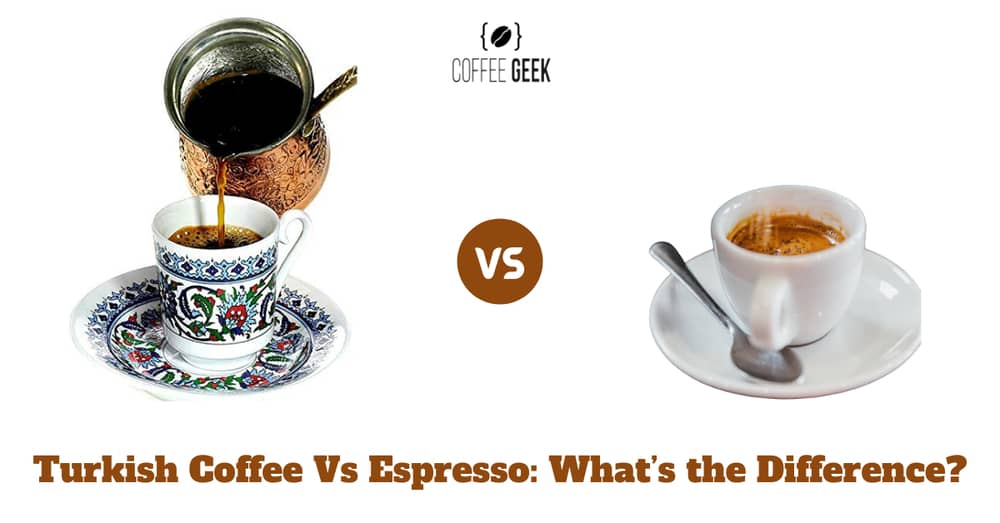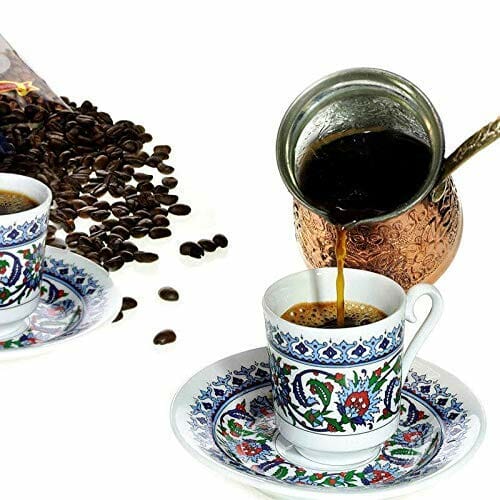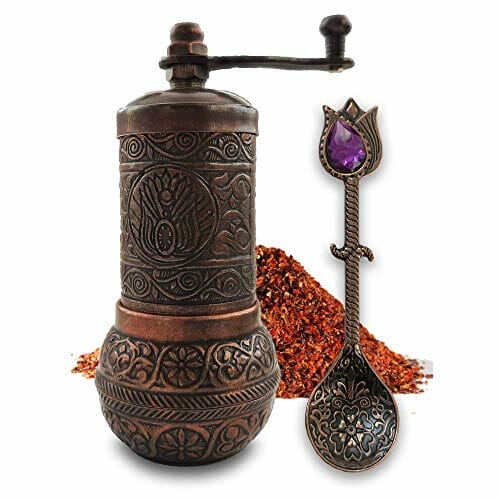If you thought Turkish coffee and espresso are one and the same, you’re mistaken. But don’t worry. You’re not alone.
There’s a whole crowd of coffee lovers who share the same idea because of these 2 beverages’ similarity in thickness and intensity.
In this article, I will help you clearly distinguish between making and drinking Turkish coffee vs espresso. The differences are fine but easier to tell than you think.
What’s Turkish Coffee?
Turkish coffee is a coffee brewing method using a Turkish coffee maker called a cezve or ibrik and very fine coffee grounds to make a cup of coffee that’s aromatic, heavy-bodied, and strong.
The Turkish coffee maker, cezve or ibrik, is essentially a coffee pot. But it’s not like other pots you have in your kitchen.
The cezve coffee pot has a long handle and a narrow neck. The former is for ease of handling and the latter is for better concentration and sustaining of the coffee foam that forms during the brewing process.
It’s traditionally made of copper with a beautiful engraved design on the body. But, these days, you can also find Turkish coffee makers in more modern designs such as ceramic or stainless steel.
Brewing Turkish coffee is very straightforward with no fluff. A fine grind and water are added to the Turkish coffee pot and brewed on an open fire.
Since there’s no filter, you’re not served with just pure coffee. Both the extracted coffee and the used ground coffee will end up in the final cup.
How Was Turkish Coffee Discovered?
Despite being called Turkish coffee, this drink didn’t originate from Turkey. Instead, Turkish coffee is known to have come from Yemen.
But, its popularization in Turkey then other countries and regions was thanks to an Ottoman governor stationing in Yemen’s recommendation to Sultan Suleiman the Magnificent.
However, it isn’t referred to as Turkish coffee everywhere.
Some countries in the Balkan Peninsula and Eastern Mediterranean region have had a feud with the Ottoman Empire or Turkey in general. And so, despite the similarities in the preparation method, they call it their coffee rather than Turkish.
Some notable examples are Armenian coffee, Bosnian coffee, Greek coffee, and Cypriot coffee.
But, to be fair, the people there have added their own twists and tweaks to the recipe, so they can stand on their own as a coffee drink apart from Turkish coffee.
Why Is Turkish Coffee So Famous?
Other than being enjoyed as a delicious coffee drink, Turkish coffee is also used in many cultural activities, ceremonies, and traditions.
For example, the sludge, the leftover grounds left at the bottom of the cup of Turkish coffee, is often used to tell fortunes, a practice of tasseography.
The beverage is also served in engagement ceremonies and holidays and is mentioned in many literary and musical pieces.
In 2013, Turkish coffee was even inscribed on the Representative List of the Intangible Cultural Heritage of Humanity of UNESCO.
So you’re not just reading about a simple coffee drink here. You’re learning about a piece of culture that’s significant to the Turkish.
How Turkish Coffee Is Made
Coffee Grounds
- Type
It’s brewed with traditionally Yemeni Mocha coffee. But the good news is you can pretty much use any type of coffee bean for Turkish coffee preparation.
Arabica coffee beans with its milder, sweeter, and lighter taste is the more popular choice as opposed to the grainer and earthier Robusta coffee.
But, feel free to experiment with both as Robusta beans’ bold coffee flavor might just be your type of grind. Don’t knock it until you’ve tried it.
- Roast
You can go easy on the roast profile of the coffee beans for Turkish coffee preparation as well. There’s no absolute rule that you have to abide by.
If this is your first time making and/or drinking this, opt for a medium roast for the most balanced Turkish coffee taste that’s not too strong or too weak.
If you like something more intense and fuller-bodied, the dark roast should be the answer.
Many coffee drinkers may prefer a lighter roast with a brighter and more complex flavor profile which can give the cup of Turkish coffee a bit more dimension.
- Grind
What you really need to pay attention to when making Turkish coffee is the grind size of the coffee grounds. It should be a much finer grind than you might expect.
When the same coffee beans are turned into powder-like extra-finely ground coffee, there’s more surface for the coffee to come into proper contact with hot water. This enables better flavor extraction, resulting in a more concentrated brew.
So, next time you grind Turkish coffee beans, go as fine as possible because you can’t go overboard with this.
Some coffee grinders may also come with a Turkish setting, so opt for that if it’s available.
And if you’re thinking of getting pre-ground Turkish coffee, unless you really need the convenience, I suggest that you grab a bag of whole bean coffee and get the Turkish grind yourself.
Pre-ground beans compromise the beans’ freshness, which can considerably affect the quality of the final cup.
You wouldn’t want to smell or taste the staleness in a cup of Turkish coffee that you poured your heart into preparing, would you?
How freshly ground beans can elevate the coffee preparation methods and the final brews is simple yet significant. So take the advice from the Coffee Geek, go the extra mile, and you can thank me later.
Water
As I briefly mentioned when explaining the Turkish coffee-making method, you need to add coffee grounds and water into the cezve and brew the mix on an open fire.
Since Turkish coffee is more concentrated than your regular cup of Joe, the coffee-to-water ratio should be adjusted to around 1:9.
If you find it too strong or too weak, add or reduce the amount of water to fit your personal preference.
Turkish Coffee Maker
And lastly, you can’t make Turkish coffee without a cezve/ibrik. We recommend this cezve/ibrik which you can easily pick up for less than $45. You won’t break the bank when indulging in exploring the world of Turkish coffee.
And before you ask, yes, there is an automatic Turkish coffee maker option for those who want the taste but would prefer to skip on the hard work.
That’s fair. But you do have to pay a steeper price to get the machine to work it out for you.
Instructions
Here is some simple guidance to help you make Turkish coffee the traditional way with a cezve/ibrik.
- Step 1: Fill the cezve with your desired amount of water or until it reaches the neck for those who don’t know where to start.
- Step 2: Add your desired amount of grounds or 1 tablespoon for the clueless coffee lovers.
- Step 3: Add sugar (around 2 teaspoons) for a sweet Turkish coffee experience. You can skip this step if you prefer a sugar-less Turkish coffee.
- Step 4: Heat the cezve on low or medium heat. Remove it off heat when it’s about to boil.
- Step 5: Use a spoon to scoop the foam. You can discard it or add it to your serving cup to be drunk later. Then stir the coffee in the cezve.
- Step 6: Return it to heat.
- Step 7: Repeat steps 4 and 5 twice more and step 6 once more. Slowly pour the coffee into a decanter or serving cup. The sludge will settle down to the bottom.
It can be consumed slowly together with a bite of the sweet and soft Turkish delight.
What’s Espresso Coffee?
You’re probably no stranger to the classic espresso shot that’s so small yet powerful with an insane amount of caffeine packed, a dark flavor, and a thick body.
But did you know that the word “espresso” originally refers to a coffee brewing method?
The barista quickly runs a small amount of near-boil water through a tightly tamped batch of very fine grind under high pressure.
As the brew gains popularity in the public, it took up the name of the brewing process and became what you know as an espresso shot.
The espresso shots are well-loved for the rich and bold flavor, full-body, and a load of caffeine to power the coffee drinkers on future endeavors.
It’s also the foundation for many espresso-based coffee drinks like latte and cappuccino (with added steamed and foamed milk).
How Espresso Coffee Is Made
Coffee Grounds
- Type
Unlike Turkish coffee for which you can use whatever type of beans and it wouldn’t matter too much, for the right espresso taste, some work a lot better with espresso machines than others, which makes them much more preferred.
Traditionally, when picking espresso beans, espresso blends of both Arabica and Robusta coffee can strike the ultimate flavor balance between the sweeter and lighter former and bolder and earthier latter.
Having Robusta beans in the mix also adds more caffeine and a more prominent layer of crema to the cup of espresso.
But you can also take the specialty coffee route by opting for 100% Arabica beans, single-origin, if possible, for more consistent flavor extraction and brighter espresso notes.
- Roast
The dark roasts are the best roast profile to bring out the full-bodied and bold taste that’s signature of espresso.
It adds oiliness and extracts the intense flavors deep inside the beans that wouldn’t be as robust as in a light roast.
Think of a darker roast than your typical drip coffee, Pour-Over, or even French Press.
- Grind
Since the process involves espresso shots being pulled in a very short brewing time, espresso blends need to be ground very finely to optimize extraction.
Want to learn more about different grind sizes for different brewing methods? Check out my Ultimate Coffee Grind Chart.
And both Turkish coffee and espresso grind should be freshly ground with a good coffee grinder right before you brew to ensure maximum freshness and quality.
Espresso Machine
To make espresso, you need help from an espresso machine as the process requires shooting hot water through the espresso grind under high pressure.
If you would like some freedom in brewing espresso to hone your coffee-making skills, consider getting a semi-automatic espresso machine.
If you’re a busy person who prioritizes convenience, a fully-automatic espresso machine can offer the solution.
Most coffee lovers may not gravitate towards a manual one as it takes a bit more time and effort to get the job done, but having complete control over the brew can be exciting and fulfilling.
If you’re having a hard time deciding on a new espresso-making partner, check out our buyer’s guide to the best espresso machines in the market.
Instructions
For detailed instructions on extracting pure coffee from the espresso grinds, read my article on how to make espresso coffee. You’re only 6 steps away from pure happiness.
Turkish Coffee Vs Espresso – How Are They Different?
And here comes the main showdown to settle the talk around espresso and Turkish coffee (hopefully) once and for all.
Turkish Coffee Vs Espresso – Coffee Beans
“Can you use Turkish coffee for espresso?”
I’ve seen this question a lot. Due to the similarities in taste, body, and fine coffee grounds, many may assume it’s okay to use their Turkish coffee bags to pull an espresso shot.
Sadly, the answer is no. But, the other way around can work, as in using espresso grinds to make Turkish coffee.
You have a lot more room to wiggle when it comes to Turkish coffee beans. As I’ve mentioned above, any type of beans of any roast should work, as long as you get the grind size right.
For espresso, dark roast is pretty much a hard budge. And if you want to make specialty espresso like the coffee houses, 100% Arabica is the way to go.
And, do espresso and Turkish coffee use the same grind size?
No, between Turkish coffee vs espresso, the former calls for a finer grind.
So if you do decide to use espresso beans to make Turkish coffee, just grind them finer and you’re set. However, using a finer grind size for espresso can result in over-extracted espresso and even portafilter clogging.
The bottom line is:
Turkish coffee to make espresso? No.
Espresso to make Turkish coffee? Heck yeah!
Turkish Coffee Vs Espresso – The Extraction
The difference in the brewing device should be obvious.
So how they’re brewed is definitely different.
When a person makes Turkish coffee, coffee grounds are steeped in water and brewed on an open fire repeatedly to form foam.
Espresso, on the other hand, is a concentrated shot that’s brewed under high pressure very quickly.
It involves pressure like the Moka Pot and AeroPress.
And, in terms of the brewing time, espresso takes a lot faster than the Turkish Joe as well (30 seconds vs 2-3 minutes).
But, the espresso machines typically brew just one shot of Joe at a time, so it can take a bit more time to make as much coffee as a cezve, which is capable of brewing up to 14 oz (414 ml).
Turkish Coffee Vs Espresso – The Strength
Is Turkish coffee stronger than espresso?
Taste-wise, yes. It’s thick, concentrated, and flavorful as the compounds are thoroughly extracted through the brewing process, which makes it taste even more intense than your intimidating espresso fellow.
But between Turkish coffee and espresso, the energy shot, likely still has more caffeine, according to Caffeine Informer. If they share the same roast, it can be comparable.
To Wrap Up
Turkish coffee and espresso may seem similar at first sight but they’re a lot more different once you dig deeper. If you’re a fan of full-bodied and strong coffee, both are great options.















